20. Fortifications
Focus: This section covers the rules on building up fortifications, how they are maintained (or reduced) and the impact of fortifications on combat.
Key Points:
- How Fortifications are created
- Construction Values and Construction Points
- How Fortifications are maintained or reduced
- Special rules for Fortifications in, or adjacent to, Major Cities
- How Fortifications affect combat
- Special Rules for Fortified Zone units
20.1 Fortification Levels
Manmade fortifications and entrenchments are represented by a fort level in each hex ranging from zero to five. The fort level in a hex and any construction towards a higher fort level is displayed in the hex pop-up for each hex (6.4).
Ground units will seek to prepare fortifications automatically if they end a turn in a hex. All defending units in a hex benefit from the fort level of the hex when in combat.
The different levels of fortification in the game reflect the amount of preparation and resources available. The following gives some idea what each level reflects:
- Level 1 - Hasty dug-in defensive positions with some earthen (just dirt) overhead cover. Heavy weapons are in basic defilade without overhead cover. Minimal camouflage. Can be accomplished within a week.
- Level 2 - Continued position improvement with squad trenches and crew served weapons pits. Moderate camouflage. Additional week or two.
- Level 3 - Connected trench networked system with both primary and alternate dug-in positions. Crew served positions in earthen bunkers with overhead cover. Additional week or two. More extensive camouflage. Typical WW1 or static eastern front positions.
- Level 4 - Introduction of interlocking concrete field fortifications with elaborate defensive engineering works
- tank traps, minefields, etc. Examples are the Panther
Line and West Wall. Field units are not able to build these
on their own and require substantial engineering assets
and planning over a period of 3-6 months.
- Level 5 - The only true “forts” in the game. Massive defensive works that take years to build. Sevastopol is an example of this type of fortification.
20.2 Fort Level Construction
For construction on a fort level to begin in a hex, there must be a combat unit in the hex. Depleted and/or frozen combat units cannot construct fort levels, isolated units are limited to building fortification levels no greater than two.
20.2.1 Unit Construction Values
Each combat unit has a construction value (displayed on the left hand side of the unit detail window). This is the sum of the construction values for each of its ground elements.
This value is affected by the fatigue and experience of the unit’s ground elements.
During the enemy player’s logistics phase, units will use their construction value toward building a fort level. Units that moved during their turn construct fort levels with the percentage of their MPs that are left. For example, if a combat unit used 4 of its 12 MPs, it will only have two thirds of its normal construction value available for building fort levels.
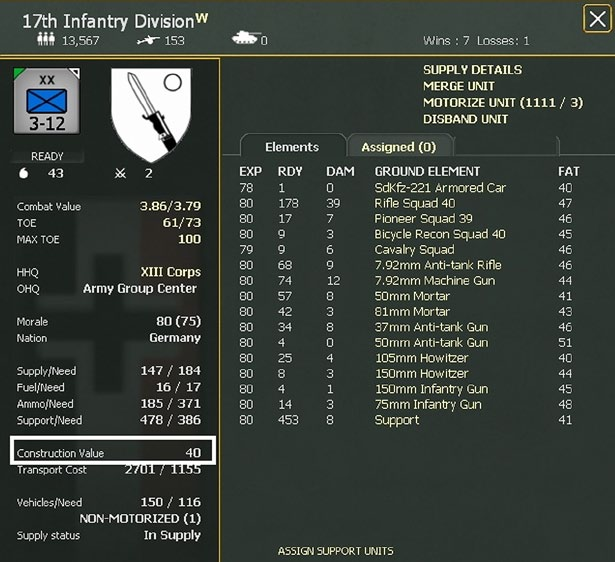
The construction value of a unit is further modified as set out below.
The existing fortification level affects the construction values as:
- Fortification level 0 – × 3
- Fortification level 1 – × 1
- Fortification level 2 – × 0.25
- Fortification level 3 – × 0.05
- Fortification level 4 – × 0.01 (these cannot be increased past 10%)
Admin Checks: Fortification build rates for building fortifications greater than 3 can be divided by 2 if a leader admin check fails.
Terrain: In a swamp hex, these values are reduced by .25 (and the maximum fortification level in a swamp hex is 3). In clear terrain, the speed of constructing a level 1 fortification is doubled to 6.
Weather affects the construction values as:
- Light Mud/Light Snow – × 0.75
- Snow – × 0.5
- Heavy Mud/Heavy Snow – × 0.33
Unit mode: A unit in static mode has their construction value multiplied by 1.1.
Proximity to the enemy: Any ground elements in the unit that are not engineer or construction types have their construction value divided by five when adjacent to an enemy unit.
Supply Levels: Construction values are also reduced based on the supply level of the unit. In no event will they be reduced below 20 percent of normal due to supply level.
20.2.2 Support Unit Construction Values
Any attached Support Units will have their construction value shown separately but this will be added to the overall construction value of the unit(s).
Using the example above, the 635th Pioneer Battalion has been added to the Infantry Division. In turn this will add 12 Construction Points to any fortification building:
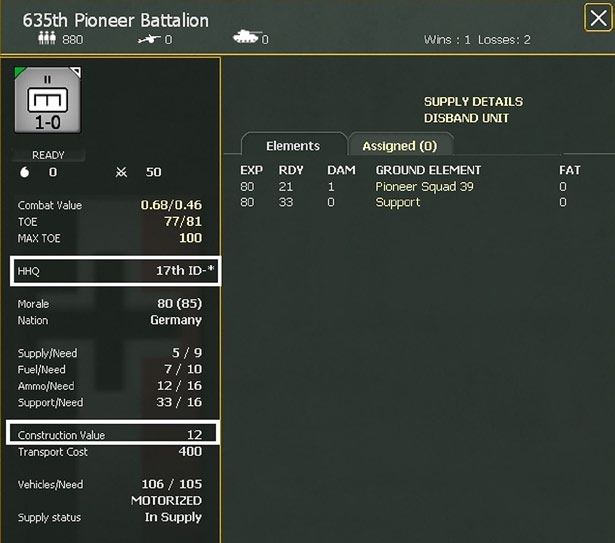
Construction and engineer support units attached to headquarters units in the combat unit’s chain of command can assist those combat units in constructing fort levels if the applicable headquarters unit passes a leader admin check. Units can draw help from support units in any HQ up the chain of command, out to a range of 20 hexes for High Command HQs, 15 hexes for Army Group HQs, 10 hexes for Army HQs and 5 hexes for Corps HQs.

Keeping with the same example, the division reports to the XIII Corps and that has 2 Construction battalions attached. These can be used to support the construction of fortifications by any unit in the same command.
Each eligible support unit may assist the fort level building of no more than one combat unit per turn.
20.2.3 Civilian Population Assistance
Town, city and urban hexes can use their population as civilian labour to help construct fortification levels to a maximum of 8 hexes if a supplied enemy unit is within 25 hexes. This range is partly dependent on the size of the population and only large cities will send out civilian labour more than a few hexes.
For Axis controlled town, city, or urban hexes that are not of German nationality, a combat unit must be present in the town, city or urban hex as well as any other hexes where fortification levels are being constructed.
The town hex must have a population of at least two. Civilian labour can only assist the construction of fortification levels in hexes with combat units where the construction of fortification levels has already begun.
Each eligible town, city or urban hex will calculate a City Labour Value (CLV) based on the population of the hex divided by eight (divided by twelve if not German or Soviet nationality), rounded down. In either case, the CLV can never exceed eight.
The town, city or urban hex will form labour teams with a construction value equal to the CLV times five, with a minimum construction value of five (for German or Soviet nationality cities, the CLV is multiplied by twenty and the minimum value is 20).
The maximum number of labour teams that may be formed is equal to the CLV of the city, with a minimum of at least one team, and only 1 team may be sent to any given hex. These teams may help in fortification level construction in hexes that are within the CLV number of hexes from the town, city or urban hex. The hexes nearest to enemy units will tend to get the help first.
The construction value of the labour team is modified in the same way as combat and support units are modified by fortification level, terrain and weather to determine the net construction points provided to a hex they are assisting.
In addition, if there are no enemy units within twelve hexes of the city, the construction value of each team is divided by four.
A hex may receive labour teams from more than one town, city or urban hex per turn. The population may become damaged from participating in fortification level construction.
For example, Koenigsberg with a German population of 17 has a CLV of 2 (17/8 rounded down). This means Koenigsberg will send out labour teams to hexes up to 2 hexes away from the city hex as soon as there is an enemy unit within 25 hexes. Each team will have a basic construction value of 40 (2x20). Up to 2 different hexes may receive help per turn. If no enemy unit was within 12 hexes of Koenigsberg (but there was an enemy unit within 25 hexes), each labour team would have a reduced construction value of 10 (40/4).

City labour may also continue to build up the fortification level of an unoccupied hex as long as the hex has some construction already underway, however, fortification level decay 20.3) may more than offset any additional fortification construction done by the city labour.
20.2.4 Construction Units
It requires fifty Construction Points to build each fortification level.
In effect, apart from in the most adverse of circumstances a division will usually be able to build a level 1 fortification in a single turn. A broken down German regiment will probably need 2 turns but this might be completed in one turn if a support unit is provided by a suitable HQ.
Any individual unit may never provide more than fifty construction points per turn (after modifications) to the construction of a hex.
In addition, a single hex can only gain fifty net construction points of fortification level per turn. For example a hex that currently is at fortification level two with fifteen percent towards fortification level three constructed, would be limited to building up to no more than fortification level three with fifteen percent towards fortification level four.
20.2.5 Supply Costs
The supply costs for fortification construction are as follows:
- Fortification 0->1: Nil
- Fortification 1->2: 2 tons per construction point (no cost for isolated units, construction rate is halved)
- Fortification 2->3: 20 tons per construction point
- Fortification 3->4: 200 tons per construction point
- Fortification 4->5: 2000 tons per construction point
Supplies are taken from a unit building the fortifications (but the unit will always retain 33% of its needs) and nearby towns. If this is not sufficient, it will be drawn from the depot network.
20.3 Fortification Limits, Decay, and Destruction
Different Fortification Levels have particular requirements and constraints:
- Fortification Level 5: Cannot be built during the game.
- Fortification Level 4: Must have a fort unit in the hex and the hex must either be City/Urban/Heavy Urban terrain or contain a port (of any size). Once built, no unit is not needed to keep the level 4 fortification.
- Fortification Levels 2 or 3: Must either be 1) adjacent to an enemy hex, or 2) a City/Urban/Heavy Urban terrain hex, or 3) contain a port (of any size), or 4) contain a fortified zone unit in the hex. Once the level 3 is reached, the condition does not have to continue to be met to keep the level 3 fortification.
- Fortification Level 1: Must be within 20 hexes of an enemy controlled hex.
If a hex meets the requirement to build to a given level, it need no longer meet the requirements of the lower levels in order to build to the lower level (i.e. a hex that qualifies for level 3 only needs to meet the Level 3 requirements in order to build to level 1, 2 or 3).
Fortification levels that have reached their maximum fortification level for the hex may continue to build up to 10 percent towards the next fortification level. So, ‘Level 5 fortifications may continue to build up to 10 percent over level 5. This allows them to take some damage and still remain at Level 5.
20.3.2 Fortification Decay
Once a fortification level is constructed, it will start to decay if the hex is not occupied by a combat unit or a city fort (with or without units inside). The chance that the fortification will decay increases as the fortification level decreases.
Depleted and Routed units will not prevent fortification decay.
Level 4 and 5 fortification levels and fortification levels on coastal hexes do not decay.
There is no fortification decay on turn 1 of any scenario.
Decay for level 0-2 fortifications may be greater due to weather conditions as follows:
| Fortification Level | Clear | Light Mud/Light Snow/Snow | Heavy Mud/Heavy Snow |
|---|---|---|---|
| 0 | 20% | 40% | 80% |
| 1 | 12% | 14% | 48% |
| 2 | 4% | 8% | 16% |
20.3.3 Fort Destruction
The fort level of a hex is set to zero whenever the control of a hex changes sides.
During an attack a fort may be partially or fully destroyed (with a corresponding effect on the defender’s CV). This can happen due to the numbers of engineers, artillery, and overall size of the attacking force. If any of these factors have reduced the fortification value it will be shown in the battle report with an indicator of how much damage they did.
In the screenshot below, a German attack was supported by sufficient combat engineering assets to degrade the defender’s fortifications even before the close combat began.

In the lower screenshot, a hasty German attack tried to dislodge a Soviet rifle brigade. Although the attack failed, the fortification level was reduced by 1, leaving the Soviet unit vulnerable if another attack occurs.

For the overall size to have had an impact then the battle must close to 50 yards in order for there to be a chance of a fort reduction.
20.4 Fortifications and Combat
Each fortification level modifies the defensive combat CV of any units in the hex (23.8.7). This will influence both the CV shown before combat starts and after the fighting is complete (so in the second example above, the Soviet brigade still gained some benefit from the remaining fortifications).
20.4.1 Artillery and Fort Levels
To better simulate the ability to pre-register fire locations, the effectiveness of the Defender’s artillery fire is related to the fort level of the hex containing the firing artillery. The higher the fort level, the more effective artillery in that hex will be in combat.
Due to their ability to participate in multiple battles, artillery support units attached to headquarters units do not receive any benefit from fort levels when committed to combat, so this benefit is limited to artillery organic to the combat units as well as artillery support units directly attached to fortified units.
20.4.2 Fort Level and AFV Damage
There is a small chance that attacking AFV ground elements may become damaged during combat by mines. The probability of damage increases with the fort level, representing the higher density of minefields.
20.4.3 Fort Level Reduction in Combat
Fort levels can be reduced during combat if the attacking force contains combat engineer ground elements (e.g. Axis Pioneers, Finnish Combat Engineers or Soviet Assault Sapper Squad) participating in the battle and due to the impact of very heavy artillery guns. These units are collectively called Engineer or Mechanized Engineer squads.
This reduction can be fractional, i.e. it doesn’t have to reduce a fort by one entire level, and it can just reduce a part of one level. Fractional reductions in fort levels take place in two percent increments. The more engineer ground elements participating, the better the chance for fort level reduction.
Engineer values are divided by the fort level when calculating their ability to reduce fort levels in combat. The chance of reducing fort levels is far greater in a deliberate attack, as engineer values are divided by four during a hasty attack and are reduced to zero if the hasty attack is changed to a scouting attack.
Fort level reduction caused by engineers can result in the reduction of the final defending modified combat value (23.8.7) with this seriously reducing the defensive CV applied in the final combat calculations.
In addition, if the attacking force is unable to force a retreat on the defender, but has a combat value ratio between 1:1 and 1:1.99, there is a chance that the defending fort level will be reduced up to one additional level, with fractional reductions once again possible. This additional one fort level reduction does not require engineer ground elements to occur, but the presence of engineers will increase the chances.
If all defending units are forced to retreat, then any fort levels in the hex are reduced to zero.
Artillery (especially Heavy Artillery) can also cause small fort reductions during combat.
In summary, the impact on fortifications of combat is:
- From artillery fire during fire combat, with heavy artillery weapons causing the greatest reduction. These reductions are generally small fractional reductions.
- If the attack was not halted, the full engineer value is applied prior to the odds calculation and may reduce the fort levels.
- Once the final combat odds and intensity level of the combat is calculated (defined by the unit size of the attacking force where a division equals 9 points but support units are not counted for this purpose), forts may be destroyed if; i. Odds are >= 1.5 or combat intensity is > 30, in this case there is an automatic 50 point fort reduction (one full fort level reduction) and possibility of additional fort reduction based on the engineer value as above but with the engineer value divided by 2. ii. Odds are >=1 and <1.5 or combat intensity is higher than 15 then 1/4 of engineer value attempts to reduce forts as above.
20.5 Fortified Units
Fortified units are special combat units designed to supplement regular combat units by assisting in the construction of fortified hexes, helping to avoid the decay of fortification levels and adding additional support units to the defence of the hex it occupies. Fortified region units have zero movement points and can never move.
These include the pre-war Soviet Fortified Zones along the border and the old Stalin Line in the Ukraine as well as placed at some key port locations. In addition, it includes the various fortified units that both sides can build as the game progresses.
20.5.1 Creating a Fortified Unit
Fortified units can be created through the expenditure of admin points by either player by selecting a hex and then selecting the “Create fortified unit” button on the map information tab or by right clicking on any hex and selecting the ‘create fortified unit’ option.
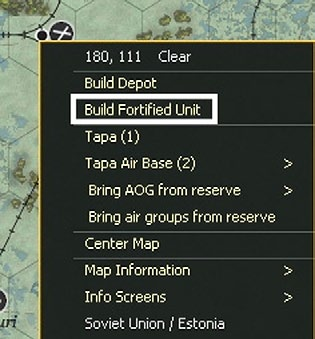
Soviet Fortified Units cost 2 and are limited to a total of 40. German units cost 4 administrative points. If the German player creates a fort in Hungary this will be of Hungarian nationality. If the fort is in Rumania, and Rumania has not yet surrendered, it will be of Rumanian nationality. If Rumania has surrendered to the Soviets then this fort will be German nationality.
Fortified units can directly attach up to three support units of any type (21.5).
The computer ignores the Admin Points for fortified unit building, but is not programmed to abuse this by building lots of fortified regions, it also faces the same absolute limit as the player(s).
20.5.2 TOE for Fortified Units
Fortified units can set their Max TOE level to 1 if desired. Units with their Max TOE set below 50 will not receive a morale increase in the logistics phase.
Note that since Depleted units will not prevent a fort level from decaying, it is important to keep the actual TOE of a Fort unit over 10 percent in order for it to prevent fort level decay and it is suggested that Max TOE be set to at least 15 for fortified zone units.
Fort type units (Fortified Regions and Fortified Zones) will become depleted if isolated and not in a hex with a friendly combat unit. If they are depleted they may then surrender if an enemy units moves adjacent to them.
20.5.3 Valid Locations for Fortified Units
Fortified zones can be placed in any friendly controlled hex, with the exception that Players may not build Fortified units in a hex next to an enemy combat unit unless that hex is also occupied by a friendly combat unit. Axis and Soviets fortified regions will be German and Soviet nationality respectively.
20.5.4 Disbanding Fortified Units
Fortified units can be disbanded like any other unit, with the exception that they do not need to be three hexes away from enemy units.
20.6 City Forts
To reflect the ability of both the Germans and Soviets to defend urban terrain, WiTE2 relaxes the normal stacking rules in urban and port hexes.
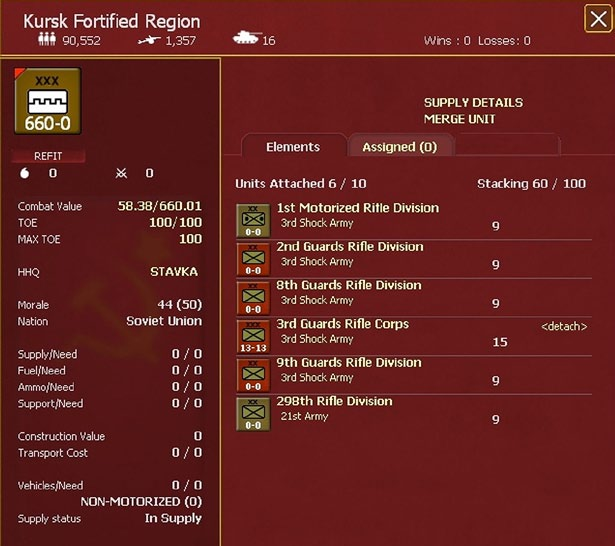
This shows a city fort in the Soviet city of Kursk. In this case 5 divisions and a Rifle Corps are now present in the city creating an impressive defensive force. This bundle of units only takes up one stacking slot (21.12) so two other Soviet units could also be in the hex.
These units do not create additional fortification levels but do make capturing well defended hexes more difficult. A “City Fort” is a notional unit that allows players to stack more combat and HQ units in any city or port hexes. The only units not allowed in a City Fort are High Command HQs, FBD/NKPS rail repair units and Fortified Zones.
20.6.1 Creation
To create one, you must select a unit in or adjacent to the urban/port hex (other than a High Command HQ) where you want to create the City Fort (currently named Fortress for Axis and Fortified Region for Soviets). On the right unit bar you will see a button on the unit that says City Fort.
Clicking on this button will pop up to allow you to attach the unit to an existing City Fort within 1 hex and/or to create a new City Fort in a potential location within 1 hex of the unit.
City Forts can only be created in friendly national hexes, so the Soviets can only build them within the 1941 boundaries of the Soviet Union and the Axis can only build them in regions owned by, or allied to Germany, on 21 June 1941. Note that some scenarios have at-start city forts that breach this rule but no new ones can be created outside these areas.
To create a city fort (this shows how to build the one shown above), any unit in the city or adjacent should be selected and then click on the city fort option:

This will then see the two pop-ups below appear. This tells you that this will build a new city fort in Kursk (some hex locations may be adjacent to more than one eligible city) and that it will cost you 10 Admin Points. If you confirm, then the fort will be built.

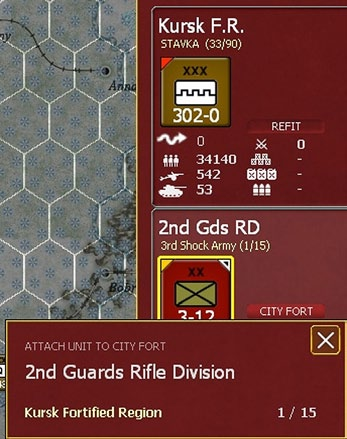
If you click on other units (in that hex or adjacent) then you now have the option to add them to the existing Kursk fortified region (which was originally the 3rd Guards Rifle Corps). Note this costs no administrative points.
Any unit assigned to the fort can be removed and when the last one is redeployed the fort will cease to exist.
20.6.2 Effect
If you create a new City Fort the unit will immediately attach itself to the City Fort.
The City Fort can’t move or attack, but it acts like an on map combat unit with all attached combat units participating in combat (including units attached to the combat units and any support units that commit to the battle from HQs contained in the City Fort or from HQs outside the fort helping combat units in the fort). The City Fort counter has its own symbol (34.2), and uses a xxx for size. On the unit bar it always shows the Defense CV – 0 MPs as it is a purely defensive unit.
In effect, the on-map City Fort counter is a container that allows additional combat and HQ units into the fort. You can view the units in the fort by going to the city fort unit detail screen and looking at the fort’s elements tab. From this tab, you can detach units from the fort, in which case they appear on map in the hex or an adjacent hex where space is available.
Each city fort can attach up to 10 on map ground units (combat and/or HQ) of up to 100 stacking point limit (where corps=15, division =9, brigade=5, regiment=3, HQ and support units=0). City fortress unit can exist on the map without any unit attached. However, they will be destroyed if an enemy unit is adjacent to them and they contain no combat units with a valid CV value (i.e. HQs/support units and depleted units don’t count).
Units in a city fort will gain 16 CPP per turn.
20.6.3 Entering and Leaving
Units that have moved in the turn are unable to either create or move into a city fort.
Units that leave a city fort will have a reduced MP but full SMP (i.e. 200).
20.6.4 City Forts and Fortification Units
You cannot build a fortification unit (20.5) in a hex with a city fort. However, it is possible to create a city fort in a hex that already has a fortification unit.
A city fort will prevent fortification decay (20.3.2) but will not build fortifications unless at least one non-depleted, non-routed unit is within the fort.